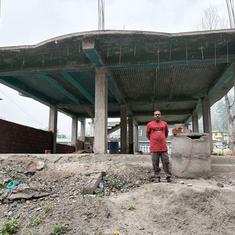Nepal, sandwiched between Asian giants India and China, is in a high-stakes battle for energy security. Now, a temporary freeze on a $500-million United States grant to Nepal has heightened the geopolitical stakes.
The grant, provided through the Millennium Challenge Corporation, a US government agency, was to boost Nepal’s electricity transmission capacity for power trade with India.
US President Donald Trump’s executive order on January 21 titled “Reevaluating and Realigning United States Foreign Aid” suspended the funding for 90 days. With no clarity on whether the freeze will be lifted, Nepal’s energy development plans have been left uncertain.
The small Himalayan country’s vast hydropower potential is often entangled in maneuvering between its two powerful neighbours. But the deeper challenge is in Nepal securing its own energy future.
Energy crisis despite vast potential
Nepal’s estimated hydropower potential is nearly 83,000 megawatts, of which around 42,000 MW can be produced economically, according to the National Bureau of Asian research. Yet, the country faces an unprecedented energy crisis – a study estimates that one-fourth of the population is still outside the reach of energy sources.
Its current installed electricity generation capacity is nearly 3,157 MW, which is insufficient to meet the rising domestic demand and ensure year-long power. Ninety percent of this electricity comes from hydropower plants, making Nepal’s energy situation vulnerable to seasonal fluctuations.
During summer, there are electricity shortages. In the monsoon, the country generates surplus electricity but does not have diversified markets to sell the excess power to.
This is where America’s Millennium Challenge Corporation compact, a five-year funding agreement, comes in. The pact, meant to finance hydroelectricity and road infrastructure, was signed in 2017 but ratified by Nepal’s Parliament in 2022 after years of political turmoil and Chinese resistance. So far, $48.24 million of the grant has been spent, including $27.82 million on electricity transmission facilities.
In August 2024, Millennium Challenge Account-Nepal and India signed a deal to construct three high-capacity electricity substations and a transmission line from New Butwal to the Nepal-India border, to enhance electricity imports from India in summer and export in the monsoon.
Significantly, in December, Nepal signed an electricity infrastructure agreement with China. If US funding is permanently withdrawn, Nepal may tilt further towards China, creating dependency on another foreign power for its energy needs.
Nepal-India projects
For decades, Nepal has been dependent on India for its energy needs and is tethered to the Indian energy market. India, too, has engaged with Nepal’s hydropower sector through long-term power trade agreements and building electricity transmission lines, such as the 400 kilovolt lines from Nepal’s Dhalkebar to Muzaffarpur, and Sitamarhi in India, with plans for further expansion.
In 2024, both sides agreed to inaugurate three more 132kV cross-border transmission lines. India also agreed to buy 10,000 MW of electricity from Nepal for 10 years. In October 2024, both countries struck up a tripartite agreement with Bangladesh and Nepal exported 40MW of electricity to Bangladesh via India.
However, since at least 2015, India-Nepal ties have been marked by several flashpoints. Nepal’s constitutional amendments that year had sparked ethnic protests, which the Himalayan country alleged were supported by India. An unofficial blockade by India further inflamed anger in Nepal.
In 2022, India’s inauguration of a new road in the disputed Kalapani region set off another diplomatic row. In 2024, Nepal’s new currency notes featuring Lipulekh and Limpiyadhura, areas administered by India, led to a heated debate on disputed borders.
At the same time, increasing nationalist rhetoric in Nepal has fuelled anti-India sentiment. Nepali experts allege that Indian companies deliberately stall progress on dam construction to maintain control, especially in border areas where India is seen to be asserting claim over Nepalese rivers and hydropower resources.
Nepal’s power officials have also alleged that India’s strict approval process for power exports has created hurdles.
For instance, India has declared that it will not buy electricity from Nepalese hydropower projects that have Chinese investment. To enforce this policy, India requires Nepalese projects to disclose financial details, including funding sources and financial institutions. India has introduced an annual renewal process for export approvals, adding layers of bureaucracy.
Amid power purchasing delays by India, Nepal has struggled to find an alternative market to sell surplus electricity produced in the monsoon, leading to power spillage. This situation has frustrated Nepali officials and cast doubts about the long-term rationale of electricity trade with India.
These concerns reinforce the perception that Nepal’s hydropower sector is being shaped by India’s strategic-interests and dictum rather than by Nepal’s economic priorities and development needs.
On December 4, China signed a contract with Nepal under the Belt and Road Initiative after seven years of negotiations since the initial pact was finalised in 2017 due to Nepal’s hesitancy in accepting aid from China.
Of the 10 projects identified under “aid-assistance financing”, the centerpiece is the proposal to develop a 220kV cross-border electricity transmission line from Jilong via Kerung in Chinese-administered Tibet to Rasuwagadhi in Nepal.
There have also been reports about discussions to build another electricity transmission line connecting Nepal’s Sankhuwasabha district to the Chinese side.
It signals deeper engagement with China and Nepal’s push to diversify its energy partnerships and markets. But the full potential of these projects are years away from being realised.
Renewable energy
Hydropower is Nepal’s chief energy source but the country must explore other renewable sources to strengthen its electricity security.
Nepal could focus on solar and wind power projects in remote and energy-hungry regions like the mountainous areas of Dolpa and Humla. This will provide stable energy and reduce dependence on centralised grid systems.
Nepal could also scale up micro and mini grid projects in rural areas. Investing in battery storage technologies will be crucial to mitigate hydropower fluctuations and alleviate pressure on electricity transmission lines, providing localised energy solutions.
Way forward
Nepal must diversify its energy portfolios rather than relying on a single market. Strengthening core infrastructure, expanding storage capacity and broadening its energy partnerships are key steps.
Balanced energy diplomacy with India, China and other players will ensure Nepal does not become overly reliant on a single partner. Nepal could create a favourable investment climate, offering incentives for diversifying its energy projects.
Nepal’s emergence as a South Asian powerhouse will be determined by its ability to balance the aspirations of major players while safeguarding its own energy security.
Mahesh Ganguly is a Junior Research Fellow based at Jamia Millia Islamia, New Delhi. He was previously associated with CRC, Jadavpur University, Kolkata. Kolkata










